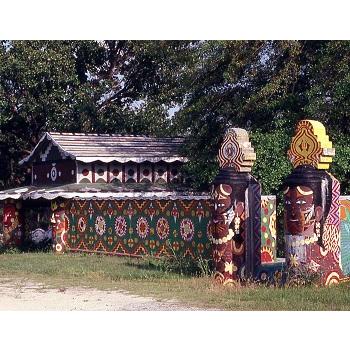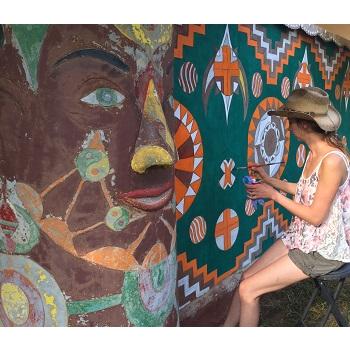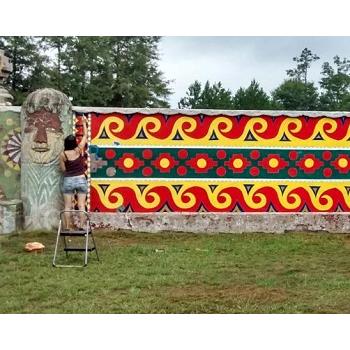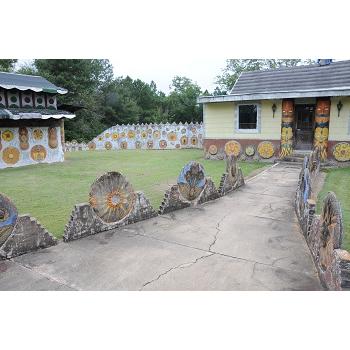St. EOM's Pasaquan
Kohler Foundation has preserved Pasaquan, the colorful art environment created by Eddie Owens Martin, known as St. EOM. The site is located in western Georgia near Buena Vista.
St. EOM created the seven acre art environment that consists of six major structures, more than 900 feet of painted masonry fence, painted totems, decorative walkways, sculptures, paintings, and other art and artifacts. The site was listed on the National Register of Historic Places in 2008 and is considered among the most important art environments in the United States. To learn more about Pasaquan, visit www.pasaquan.blogspot.com.
The Pasaquan Preservation Society (PPS) took responsibility for the site in 1986. This group of preservation-minded and dedicated supporters dreamed of seeing Pasaquan preserved and sought out Kohler Foundation to fulfill that dream.
In 2014, Kohler Foundation was approached by Fred Fussell, a member of the board of directors of the Pasaquan Preservation Society, to see if the Foundation might have an interest in helping preserve Pasaquan. While the group had been caring stewards of Pasaquan, they did not have the resources to address the growing deterioration, paint loss, and numerous structural problems. The Board of Directors of Kohler Foundation agreed to take on the project, and preservation of Pasaquan began.
The site was in poor condition and was clearly threatened by age and the elements, but a wealth of photo documentation and first person knowledge shared by people like Fred Fussell, other PPS board members, and local residents, all contributed to the body of knowledge that allowed conservators to bring the art environment back to the way it looked when St. EOM created it.
The preservation of Pasaquan has taken roughly two years and is among the largest and the most complex projects Kohler Foundation has ever taken on. Work has included a seemingly endless array of object and painting conservation challenges. It has been painstaking work, much done in the heat of summer under canvas tenting to provide needed shade.
A team of objects conservators was brought in from International Artifacts (Houston and Los Angeles) and painting conservators came from Parma Conservation (Chicago). Objects conservators stabilized the artwork, filled cracks and areas of loss, and added foundations as needed to provide a ready and stable surface for the painting conservators. Other skilled technicians and craftspeople came from Kansas and Wisconsin to assist. Local tradespeople under highly skilled general contractor T.G. Gregory of Columbus, GA addressed structural concerns and functionality in the six buildings, dealing with a wide range of issues including heavy termite damage, foundations with rotting wood stumps for support, structural and safety concerns in buildings, intricately patterned floors and roofing needing to be reproduced, and not a level or straight line in any of the structures. In addition, interns from Columbus State University shared their energy and talent working on documentation, organization of archives, and assisting with conservation. A group of three young men from Buena Vista were recruited to help at the site and they proved to be amazing conservation assistants.
Pasaquan was officially gifted to Columbus State University (CSU) in Columbus, Georgia; they will care for the environment into the future. Under the direction of Professor Mike McFalls in the University’s Department of Art, we are watching as they breathe new life into Pasaquan with events, programming, educational outreach, and tours. An artist now resides full time at Pasaquan (in the guest cottage) to provide security and ongoing care to the site. Pasaquan opens to the public in October 2016. Dr. Tim Meson, former President of CSU, has been quoted as saying this is “an effort that will have indelible and positive impact on the region”. Kohler Foundation believes this to be true!
Some of St. EOM’s art has been removed from the site and has been conserved. These pieces now reside in the permanent collections at Columbus State University and the John Michael Kohler Arts Center. It is the philosophy of Kohler Foundation to place select pieces in permanent collection in case a natural disaster would ever cause extensive damage at the site; this ensures at least a small group of works will always be safe, now and into the future.
Columbus State University has put together a digital archive of Pasaquan photos and documentation called In Transition: The Visionary Art Environment of Pasaquan.







